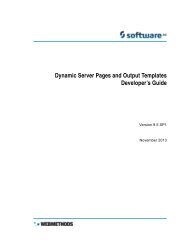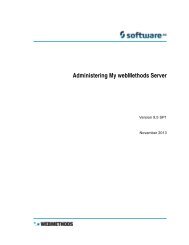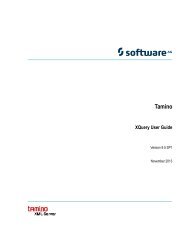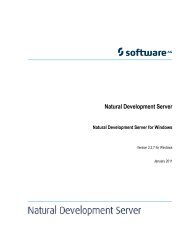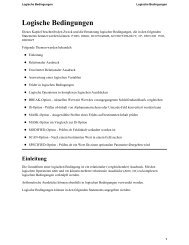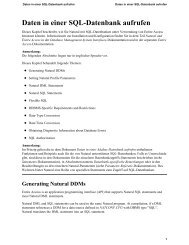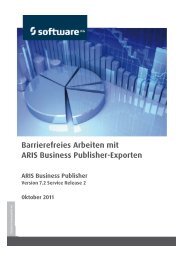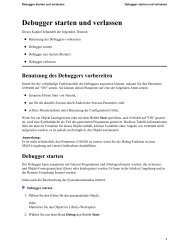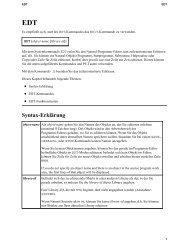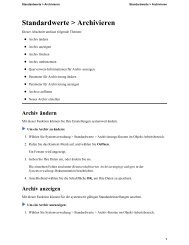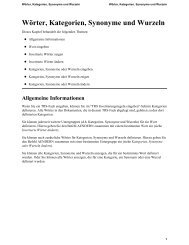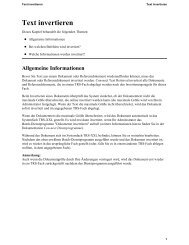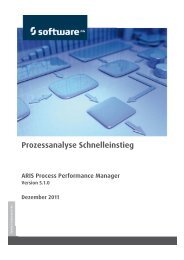Ending Entire System Server - Software AG Documentation
Ending Entire System Server - Software AG Documentation
Ending Entire System Server - Software AG Documentation
You also want an ePaper? Increase the reach of your titles
YUMPU automatically turns print PDFs into web optimized ePapers that Google loves.
New startup parameter SHUTDOWN-MAX-DELAY limits the Deferred Shutdown to a specified number<br />
of seconds. If the time limit is reached, <strong>Entire</strong> <strong>System</strong> <strong>Server</strong> will terminate without properly<br />
closing down the SAT tasks.<br />
If this situation occurs, you must check why the SAT products did not stop within the defined<br />
time interval. In this case, <strong>Software</strong> <strong>AG</strong> support should be consulted, if necessary.<br />
As the SAT monitors have wait cycles, SHUTDOWN-MAX-DELAY=180 should be used initially. If all<br />
NATURAL-SUB-TASKS are stopped, the ESY termination will be continued without further delays.<br />
BS2000/OSD Security Considerations<br />
The <strong>Entire</strong> <strong>System</strong> <strong>Server</strong> tasks access datasets and other resources as requested by the Natural<br />
user. To be able to do this for various users, the <strong>Entire</strong> <strong>System</strong> <strong>Server</strong> must run under BS2000/OSD<br />
user ID TSOS. Users' access rights are checked by the <strong>Entire</strong> <strong>System</strong> <strong>Server</strong> in order to provide<br />
access to BS2000/OSD objects in the same range as if working under TIAM. Therefore, the Natural<br />
user must identify himself to <strong>Entire</strong> <strong>System</strong> <strong>Server</strong> before any view can be accessed.<br />
A logon operation must be performed, specifying the user's system user ID and password. If<br />
SECURITY=BS2 was specified in startup parameters, user ID and password are checked against the<br />
system's user definition file (TSOSJOIN). If this validation is successful, the user ID will from then<br />
on be used for future validations until it is changed by another logon operation.<br />
If the user attempts to access a view before logging on, Response Code 510 (LOGON REQUIRED) is<br />
returned. However, if the startup parameter AUTOLOG is set to YES, an implicit logon is performed<br />
as part of the first user request.<br />
If the Natural user ID (BS2000/OSD logon user ID for batch, or TIAM, *USER for openUTM) is not<br />
defined in BS2000/OSD, Response Code 510 (LOGON REQUIRED) is returned. For Natural/UTM,<br />
TSOS is not allowed as *USER and will be rejected.<br />
The <strong>Entire</strong> <strong>System</strong> <strong>Server</strong> online tutorial contains a sample logon program that uses view NAT-<br />
PROC-LOGON.<br />
The logon operation is not needed if <strong>Entire</strong> <strong>System</strong> <strong>Server</strong> is used in single-user mode.<br />
If SECURITY=USER is specified in the startup parameters, exit USERLSEC is called to check the user<br />
ID and password as required at your site, and not against the system's user definition file<br />
(TSOSJOIN). For a sample exit USERLSEC, see the supplied Source Library.<br />
If no security system interface is requested (startup parameter SECURITY=NONE), no security check<br />
is performed: all logon attempts will be successful. If in this case the Natural user ID is not defined<br />
in BS2000/OSD, only functions which do not require a BS2000/OSD user ID are available (such as<br />
EVENTING).<br />
Administration<br />
BS2000/OSD Considerations<br />
123



